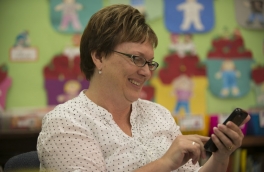School Funding
Our Kids Can't Wait
Strong schools work for our students, our communities, and Maryland. But right now in too many places in our state, kids don’t have the same access to a great education. As the state revises Maryland's school funding formula for the first time in nearly two decades, we have a once-in-a-generation opportunity to revamp and improve how Maryland funds our schools.
A 2016 study presented to the Kirwan Commission, a group of 25 education leaders tasked with revising the state’s funding formula, found that Maryland public schools are annually underfunded by $2.9 billion. That’s an average of $2 million in underfunding in each and every school in Maryland.
During the 2019 General Assembly session, legislators in Annapolis took important first steps, based on the work of the Kirwan Commission, to address the underfunding of our schools by passing the Blueprint for Maryland's Future. The bill increases education funding by $1.1 billion over the next three years to raise teacher pay and implement programs to help low-income and special education students. Thanks to the bill, teachers and other educators will see their largest raise since the 2008 recession. Schools will hire more special educators and paraprofessionals to help struggling learners and students with disabilities. More than 200 high-poverty schools will become community schools where wrap-around services such as counseling and healthcare will break down economic barriers to learning. This bipartisan legislation—on the heels of the March for Our Schools, the largest rally in Annapolis in nearly a decade—is a bold first step toward Maryland’s future success.
In November 2019—after three years of meetings, research, and public hearings about Maryland’s underfunded public schools—the Kirwan Commission held its final meeting and took its final votes. The commission's recommendations include proven measures such as expanding career technical education, community schools, and pre-k; increasing educator pay; hiring more educators to increase individual attention for students and to expand teacher planning and collaboration time; and providing more support for special education and mental health services. Phased in over 10 years, implementing these recommendations would lead to an additional $4 billion invested in public schools across Maryland.
The Kirwan Commission recommendations have been introduced in the 2020 General Assembly as HB 1000/SB 1300, the Blueprint for Maryland's Future. Legislators have until April 6, the final day of session, to debate, potentially amend, and vote on a new funding formula and how the Blueprint will be implemented and funded. Throughout session, MSEA will stay at the forefront of fighting for a significant increase in the resources and opportunities available to every student in Maryland.
For the latest news on school funding in Maryland, visit MSEA Newsfeed.
The Effects of Underfunding
The percentage of Maryland public school students living in poverty has more than doubled since 1990—from 22% to 45%—putting our statewide student population on the verge of becoming majority low-income. Since the last time the state funding formula was revised nearly 20 years ago, the percentage of English language learners, who require more staff and resources to catch up and stay on track with their English-speaking peers, has doubled. The number of students receiving special education services has also increased markedly. Maryland now ranks near the bottom of all states for funding poor districts and affluent district evenly, with federal education data showing that Maryland’s poorest school districts receive 5% less state and local education funding than Maryland’s wealthiest districts.
This underfunding has resulted in an increasing student to teacher ratio, meaning larger class sizes and less individualized instruction. Maryland teachers make 84 cents on the dollar compared to peers in similar fields with similar levels of education. Far too many support staff don’t make a living wage and must work multiple jobs to make ends meet. A statewide survey of educators in 2019 found that 50% of educators work a second job to make ends meet and 94% buy school supplies for their students out of their own pockets. Poll after poll has shown that Marylanders overwhelmingly want to close the funding gap in the state. For example, a September 2019 poll found that 71% of Marylanders said they favor the effort “to pass a school funding and policy plan that will significantly increase school funding."
Voters Overwhelmingly Pass Question 1 to Fix the Fund
When Marylanders approved casino gaming, voters thought the new revenue would increase education funding. But instead, Gov. O'Malley used $500 million of that money elsewhere in his budgets, followed by Gov. Hogan diverting $1.4 billion of casino money to plug holes in other parts of his budgets. In 2018, educators successfully fought for the passage of the Fix the Fund Act, which put a constitutional amendment on the November ballot (Question 1) to finally stop this budget gimmick and provide a $500 million annual increase in school funding. Question 1 passed overwhelmingly, with more votes than anything else on the ballot and by the widest margin of any Maryland ballot measure in more than 20 years. It's clear that Marylanders want increased funding for public schools, and Question 1 was the first step in making that a reality.
Related News
PARCC Scores Show Schools Are Underfunded
“This year’s PARCC scores are a reflection of the fact that our schools are underfunded. When you have class sizes of more than 30 kids to a teacher, when you have high teacher turnover rates because we underpay educators, and when you don’t address the non-academic barriers to learning in our communities of high poverty, you see achievement gaps persist. It’s not enough to talk about test scores—kids are never going to test their way out of poverty. We need more funding in our public schools to meet the needs of every child, and until then you’re going to keep seeing the same results," said MSEA President Betty Weller.
Sen. Madaleno, ACLU of Maryland, and Educators Call on Gov. Hogan to Withhold Funding for Private Schools
Earlier this week, the governor claimed the state is facing declining revenues in deciding to withhold $25 million that had been set aside for public schools, yet did not decide to hold back funding reserved for private schools. Sen. Madaleno, ACLU, and MSEA asked the governor to instead send the $5 million in taxpayer dollars to public schools to offset some of the damage from the cuts Gov. Hogan made earlier this week.
MSEA Statement on Gov. Hogan’s Political Decision to Withhold School Funding (Again)
Gov. Hogan’s office announced he would be withholding approximately $80 million included in the General Assembly’s bipartisan FY2017 budget—including $25 million for public schools. This is the second consecutive year that Gov. Hogan has made the unilateral decision to withhold funding from schools.
MSEA Launches Video and Digital Ad Campaign to Call on Gov. Hogan to Release School Funding
MSEA launches a new video and digital advertising campaign asking Marylanders to urge Gov. Hogan to release $68 million in education funding included in the General Assembly’s passed budget. A broad, bipartisan coalition of educators, parents, school board members, superintendents, county officials, and state legislators have been holding local events since the end of the legislative session to urge Gov. Hogan to release this funding for our schools
Educators Advance Pro-Public Education Policies During General Assembly Session
“Public education came under assault this legislative session, but between incredible educator and parent engagement and pro-public education champions in the General Assembly, we were able to pass a budget that continues a strong commitment to public education,” said MSEA President Betty Weller. “Crucial funding is now available for our schools—all Gov. Hogan needs to do is fund it. He can do the right thing for our schools, or he can willingly make things harder for our students to succeed."


